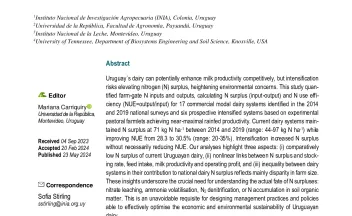Balancing nitrogen at the farm gate: Economic-environmental sustainability trade-off in pastoral dairy systems of Uruguay. [Balanceando el nitrógeno en la portera del predio: Sostenibilidad económica y ambiental en los sistemas lecheros pastoriles de Uruguay.]. [Equilibrando o nitrogênio no portão da propriedade: Sustentabilidade econômica e ambiental nos sistemas leiteiros pastoris do Uruguai.]

ABSTRACT.- Uruguay's dairy can potentially enhance milk productivity competitively, but intensification risks elevating nitrogen (N) surplus, heightening environmental concerns. This study quantified farm-gate N inputs and outputs, calculating N surplus (input-output) and N use efficiency (NUE=output/input) for 17 commercial modal dairy systems identified in the 2014 and 2019 national surveys and six prospective intensified systems based on experimental pastoral farmlets achieving near-maximal rainfed productivity. .-.-.-.-.-.-.-.-.-.



